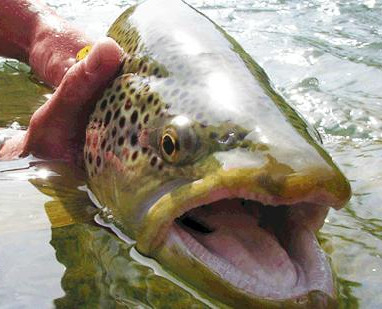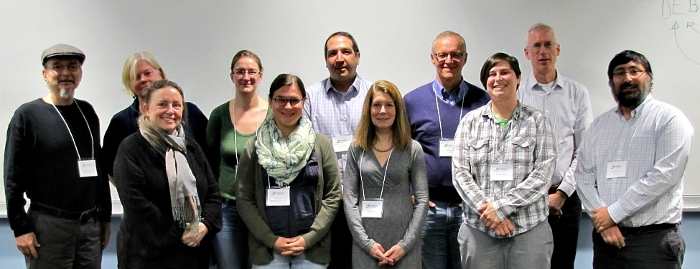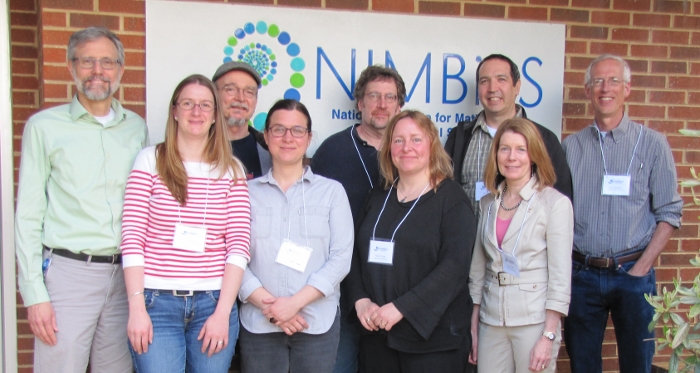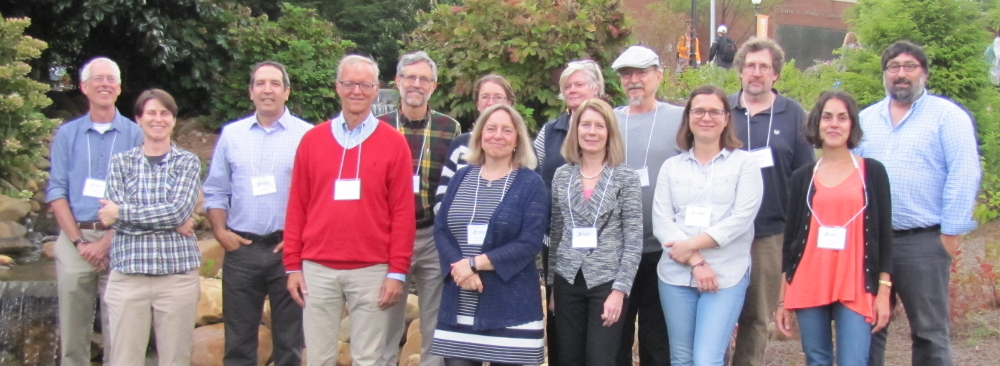| Description | Participants | Summaries | Products |
|---|

NIMBioS Working Group
Modeling Organisms-to-Ecosystems
Topic: Dynamic models to link organism performance to ecosystem service delivery for ecological risk assessment of chemicals
Meeting dates: November 16–20, 2015; April 4–7, 2016; September 26–29, 2016; September 12–15, 2017
Organizers:
Valery E. Forbes, School of Biological Sciences, University of Nebraska-Lincoln
Christopher Salice, Director of Environmental Science and Studies, The Jess and Mildred Fisher College of Science and Mathematics, Towson University, Towson, MD
Objectives: Although protection goals for the ecological risk assessment of chemicals are increasingly being framed in terms of ecosystem service delivery, the type of data collected to assess risk is generally at the level of individual organisms. Currently, extrapolation from what is measured to what we want to protect uses overly simplistic approaches (i.e., hazard or risk quotients or species sensitivity distributions) that are not solidly grounded in biology or mathematics. This multidisciplinary working group brings together population-, community-, and ecosystem ecologists, ecotoxicologists, and mathematicians with interest and expertise in developing dynamic, mechanistic models of complex systems to predict impacts on ecosystem function and service delivery from data typically collected to support chemical risk assessments. In particular, the models that we develop will be designed to bridge the gap between the properties of populations and the delivery of ecosystem services. The working group will use a case study approach focused on two commonly used species to demonstrate proof of concept and will aim to develop, not only example models, but a general framework for model development, evaluation, and communication that can be applied across different ecosystem services and ecotoxicological endpoints. The working group will be closely coordinated with the working group Modeling Molecules-to-Organisms chaired by Cheryl Murphy and Roger Nisbet, using the same case study species (i.e. daphnids and trout), with the intent to develop a modeling framework that ultimately addresses adverse outcome pathways (AOPs) that can mathematically link from molecular responses through whole organism responses to ecosystem service delivery.
Ideas for this working group benefited from discussions at the NIMBioS Investigative Workshop on Predictive Models for Ecological Risk Assessment

Meeting Summaries
| Mtg # | Dates | Agenda | Summary | Photo | Evaluation |
|---|---|---|---|---|---|
| 1 | Nov 16-20, 2015 | Link | Link | Report | |
| 2 | Apr 4-7, 2016 | Link | Link | ||
| 3 | Sep 26-29, 2016 | Link | Link | ||
| 4 | Sep 12-15, 2017 | Link | Link |
Meeting 1 Summary. The first meeting occurred simultaneously with the NIMBioS Working Group: Modeling Molecules to Organisms. Both groups met daily for updates but spent most of the time working independently. The first day was spent with introductions and sharing of research experience and expertise, ending with a discussion on meeting objectives. A main goal was to develop a conceptual framework that would link toxicant-induced effects on individuals to the delivery of ecosystem services using Daphnia magna and rainbow trout as case studies. Day 2 was devoted to formalizing this framework. Each participant developed and presented a visual model describing his or her ideas for the overall conceptual framework. Through discussion, the group reached consensus on a visual representation of how we would link toxicant effects on individuals (obtained for toxicity studies) to ecosystem services. For days 3 and 4 of the meeting, small groups were formed to focus on particular elements of the conceptual framework to consider: dynamic energy budgets as a framework for connecting individuals to lower levels of organization (to integrate with our sister Working Group); linking individuals to populations; linking populations to multi-species systems; and linking properties of populations and ecosystems to ecosystem service delivery. At meeting completion, we identified several tasks to complete before the next meeting in April. These included developing a manuscript describing the conceptual framework, developing mathematical models for the different levels within the framework, and proposing a session on the Working Group for an upcoming meeting of the Society of Environmental Toxicology and Chemistry.
Meeting 2 Summary. The group continued the discussions and work initiated during the first meeting 1 and made progress toward addressing agreed upon objectives. A newly recruited group member gave a presentation on Ecosystem Services that advanced the group’s understanding of ecological production functions. The group worked on our two model species/systems (daphnia and trout) to design scenarios and implement toxicant effects. The group decided to investigate the effects of alpha-ethinyl-estradiol (EE2) on two competing trout species inhabiting a freshwater stream. For the second case study on daphnia, the group discussed what ecosystem services to include and how to relate these to model outputs. Subgroups focused on implementing control theory into current, but simple, model constructs, integrating Dynamic Energy Budget models into the existing trout model (inStream), and refining the multi-species model, AQUATOX, for the Working Group purposes. We also prepared the first draft of an Environmental Toxicology and Chemistry Focus article, which includes refined conceptual models. Finally, the group selected dates for the third meeting in late September. Tasks to be completed before the third meeting include: proof of concept analyses for control theory, continued implementation of DEB into inStream, finalization of the Focus article, and continued development of AQUATOX for the daphnia scenario (for The International Society for Ecological Modelling Global Conference 2016 in early May).
Meeting 3 Summary. TBA
Meeting 4 Summary. TBA
 |
| Mtg. 1 participants (L to R): Rob Pastorok, Yetta Jager, Pernille Thorbek, Virginie Ducrot, Nika Galic, Christopher Salice, Valery Forbes, Bjorn Birnir, Kristina Garber, Steve Railsback, Andrew Kanarek. Not pictured: Richard Rebarber |
 |
| Mtg. 2 participants (L to R): Randy Bruins, Virginie Ducrot, Rob Pastorok, Nika Galic, Richard Rebarber, Pernille Thorbek, Christopher Salice, Valery Forbes, Steve Railsback. |
 |
| Mtg. 3 participants (L to R): Christopher Salice, Andrew Kanarek, Richard Rebarber, Yetta Jager, Roger Nisbet, Virginie Ducrot, Rob Pastorok, Valery Forbes, Bjorn Birnir, Pernille Thorbek, Randy Bruins, Nika Galic. (Kneeling): Kristina Garber, Steve Railsback. |
 |
| Mtg. 4 participants (L to R): Steve Railsback, Kristina Garber, Christopher Salice, Bjorn Birnir, Randy Bruins, Virginie Ducrot, Pernille Thorbek, Yetta Jager, Valery Forbes, Rob Pastorok, Nika Galic, Richard Rebarber, Chiara Accolla, Andrew Kanarek |
 |
| Combined Meeting 4 participants, Molecules-to-Organisms and Organisms-to-Ecosystems Working Groups |
NIMBioS Working Groups are chosen to focus on major scientific questions at the interface between biology and mathematics. NIMBioS is particularly interested in questions that integrate diverse fields, require synthesis at multiple scales, and/or make use of or require development of new mathematical/computational approaches. NIMBioS Working Groups are relatively small (up to 10 participants), focus on a well-defined topic, and have well-defined goals and metrics of success. Working Groups will meet up to 3 times over a two-year period, with each meeting lasting up to 2.5 days.
A goal of NIMBioS is to enhance the cadre of researchers capable of interdisciplinary efforts across mathematics and biology. As part of this goal, NIMBioS is committed to promoting diversity in all its activities. Diversity is considered in all its aspects, social and scientific, including gender, ethnicity, scientific field, career stage, geography and type of home institution. Questions regarding diversity issues should be directed to diversity@nimbios.org. You can read more about our Diversity Plan on our NIMBioS Policies web page. The NIMBioS building is fully handicapped accessible.
NIMBioS
1122 Volunteer Blvd., Suite 106
University of Tennessee
Knoxville,
TN 37996-3410
PH: (865) 974-9334
FAX: (865) 974-9461
Contact NIMBioS


